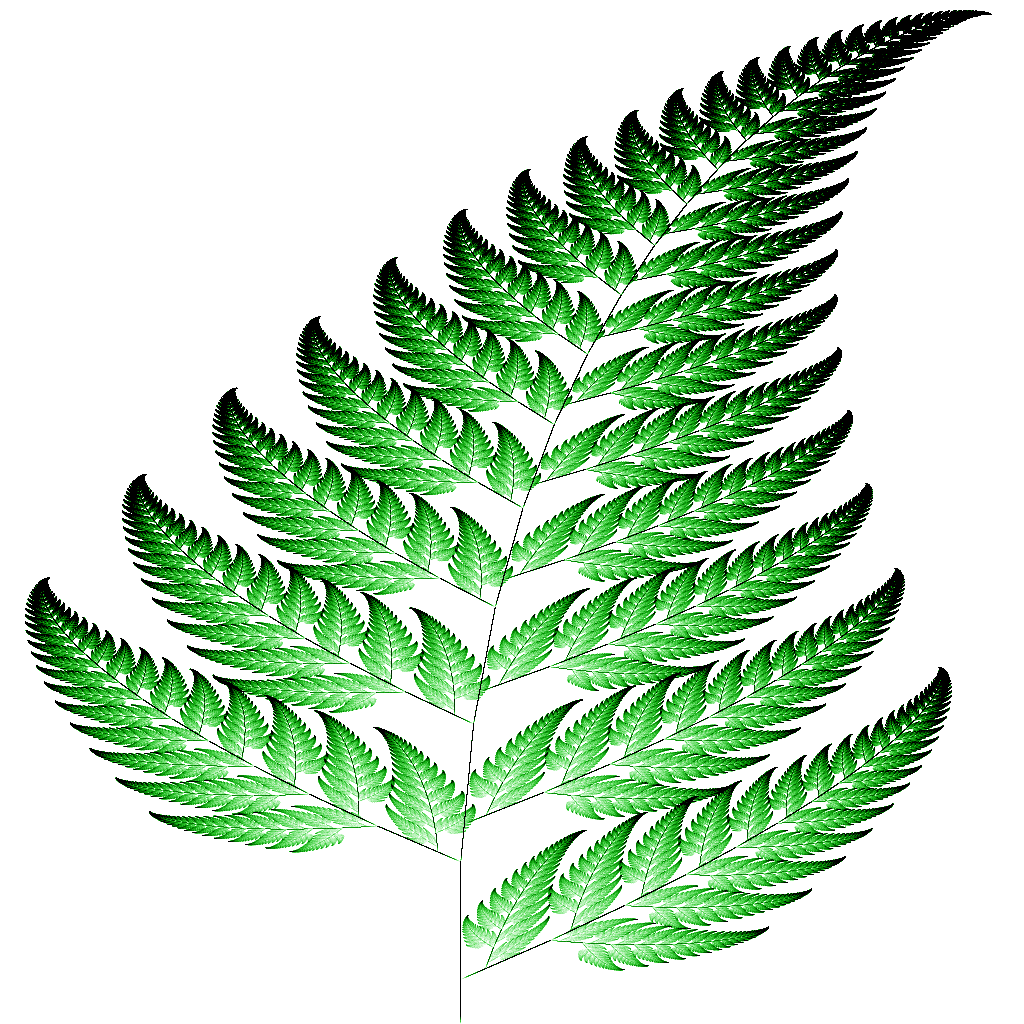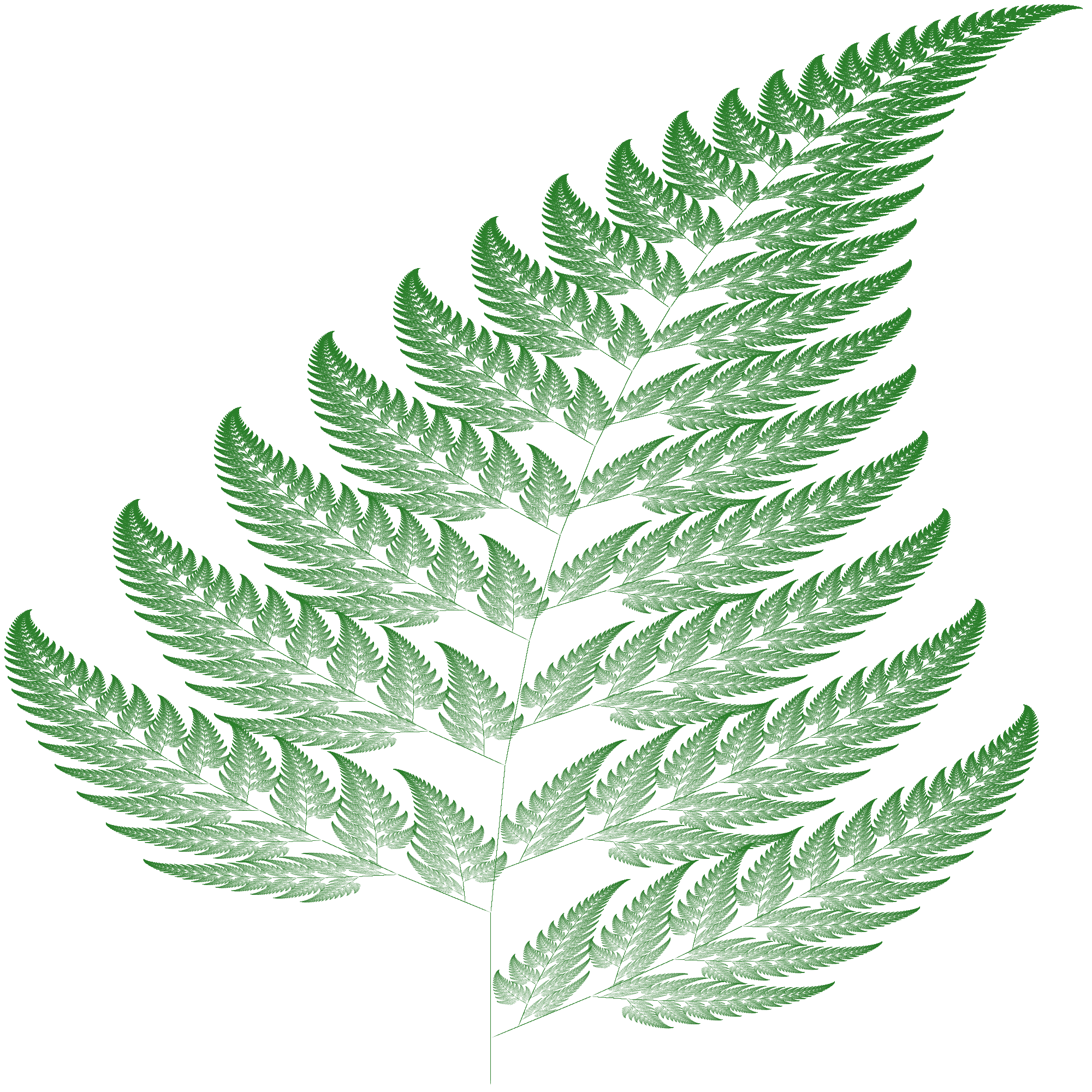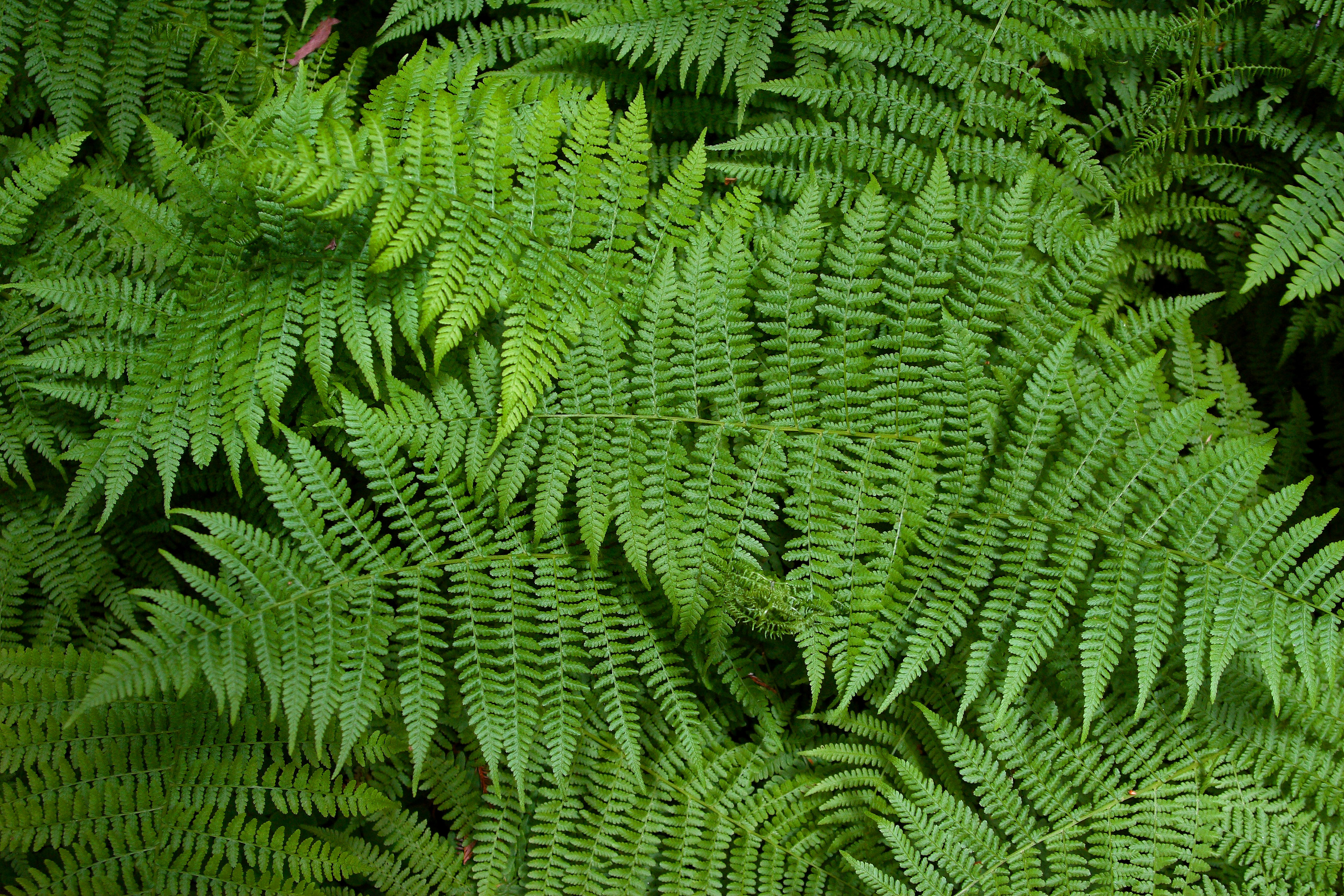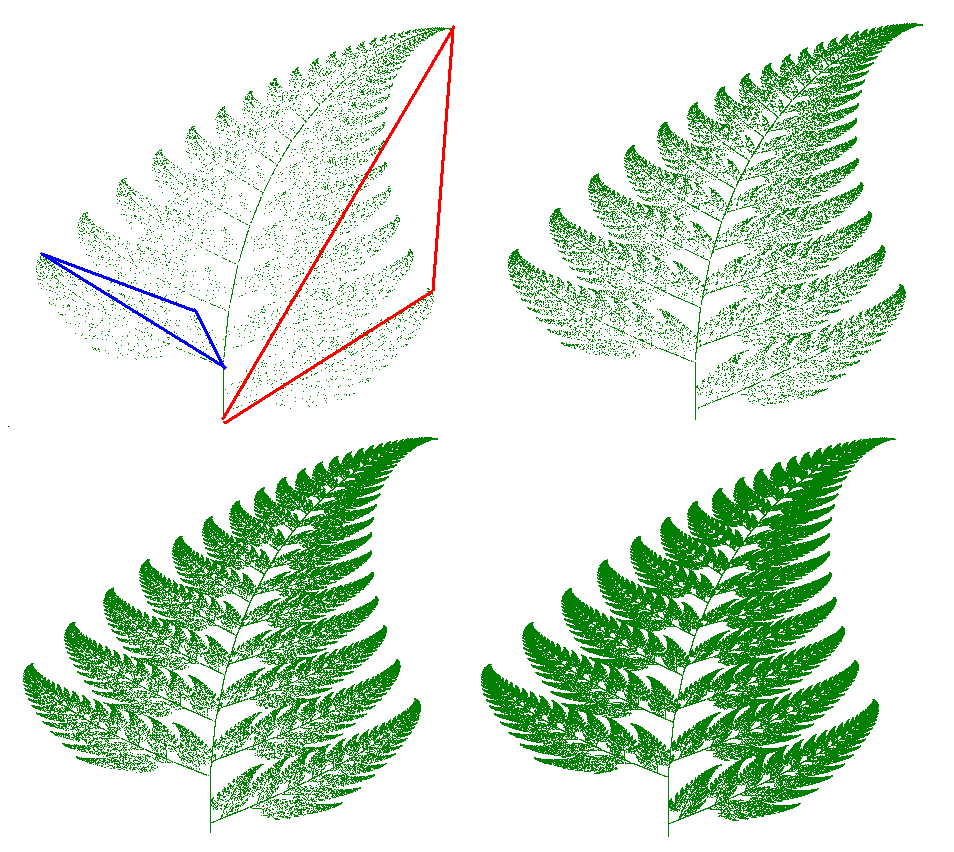Barnsley's fern on:
[Wikipedia]
[Google]
[Amazon]
 The Barnsley fern is a fractal named after the British
The Barnsley fern is a fractal named after the British
Boston, MA: Academic Press, 1993, He made it to resemble the black spleenwort, '' Asplenium adiantum-nigrum''.
 The fern code developed by Barnsley is an example of an iterated function system (IFS) to create a fractal. This follows from the collage theorem. He has used fractals to model a diverse range of phenomena
in science and technology, but most specifically plant structures.
—Michael Barnsley ''et al.''
The fern code developed by Barnsley is an example of an iterated function system (IFS) to create a fractal. This follows from the collage theorem. He has used fractals to model a diverse range of phenomena
in science and technology, but most specifically plant structures.
—Michael Barnsley ''et al.''
 Barnsley's fern uses four affine transformations. The formula for one transformation is the following:
:
Barnsley shows the ''IFS'' code for his ''Black Spleenwort'' fern fractal as a matrix of values shown in a table.''Fractals Everywhere'', table III.3, IFS code for a fern. In the table, the columns "a" through "f" are the coefficients of the equation, and "p" represents the probability factor.
These correspond to the following transformations:
:
:
:
:
Barnsley's fern uses four affine transformations. The formula for one transformation is the following:
:
Barnsley shows the ''IFS'' code for his ''Black Spleenwort'' fern fractal as a matrix of values shown in a table.''Fractals Everywhere'', table III.3, IFS code for a fern. In the table, the columns "a" through "f" are the coefficients of the equation, and "p" represents the probability factor.
These correspond to the following transformations:
:
:
:
:
 Though Barnsley's fern could in theory be plotted by hand with a pen and graph paper, the number of iterations necessary runs into the tens of thousands, which makes use of a computer practically mandatory. Many different computer models of Barnsley's fern are popular with contemporary mathematicians. As long as math is programmed correctly using Barnsley's matrix of constants, the same fern shape will be produced.
The first point drawn is at the origin (''x''0 = 0, ''y''0 = 0) and then the new points are iteratively computed by randomly applying one of the following four coordinate transformations:
''ƒ''1
:''x''''n'' + 1 = 0
:''y''''n'' + 1 = 0.16 ''y''''n''.
This coordinate transformation is chosen 1% of the time and just maps any point to a point in the first line segment at the base of the stem. This part of the figure is the first to be completed during the course of iterations.
''ƒ''2
:''x''''n'' + 1 = 0.85 ''x''''n'' + 0.04 ''y''''n''
:''y''''n'' + 1 = −0.04 ''x''''n'' + 0.85 ''y''''n'' + 1.6.
This coordinate transformation is chosen 85% of the time and maps any point inside the leaflet represented by the red triangle to a point inside the opposite, smaller leaflet represented by the blue triangle in the figure.
''ƒ''3
:''x''''n'' + 1 = 0.2 ''x''''n'' − 0.26 ''y''''n''
:''y''''n'' + 1 = 0.23 ''x''''n'' + 0.22 ''y''''n'' + 1.6.
This coordinate transformation is chosen 7% of the time and maps any point inside the leaflet (or ''pinna'') represented by the blue triangle to a point inside the alternating corresponding triangle across the stem (it flips it).
''ƒ''4
:''x''''n'' + 1 = −0.15 ''x''''n'' + 0.28 ''y''''n''
:''y''''n'' + 1 = 0.26 ''x''''n'' + 0.24 ''y''''n'' + 0.44.
This coordinate transformation is chosen 7% of the time and maps any point inside the leaflet (or ''pinna'') represented by the blue triangle to a point inside the alternating corresponding triangle across the stem (without flipping it).
The first coordinate transformation draws the stem. The second generates successive copies of the stem and bottom fronds to make the complete fern. The third draws the bottom frond on the left. The fourth draws the bottom frond on the right. The recursive nature of the IFS guarantees that the whole is a larger replica of each frond. Note that the complete fern is within the range −2.1820 < ''x'' < 2.6558 and 0 ≤ ''y'' < 9.9983.
Though Barnsley's fern could in theory be plotted by hand with a pen and graph paper, the number of iterations necessary runs into the tens of thousands, which makes use of a computer practically mandatory. Many different computer models of Barnsley's fern are popular with contemporary mathematicians. As long as math is programmed correctly using Barnsley's matrix of constants, the same fern shape will be produced.
The first point drawn is at the origin (''x''0 = 0, ''y''0 = 0) and then the new points are iteratively computed by randomly applying one of the following four coordinate transformations:
''ƒ''1
:''x''''n'' + 1 = 0
:''y''''n'' + 1 = 0.16 ''y''''n''.
This coordinate transformation is chosen 1% of the time and just maps any point to a point in the first line segment at the base of the stem. This part of the figure is the first to be completed during the course of iterations.
''ƒ''2
:''x''''n'' + 1 = 0.85 ''x''''n'' + 0.04 ''y''''n''
:''y''''n'' + 1 = −0.04 ''x''''n'' + 0.85 ''y''''n'' + 1.6.
This coordinate transformation is chosen 85% of the time and maps any point inside the leaflet represented by the red triangle to a point inside the opposite, smaller leaflet represented by the blue triangle in the figure.
''ƒ''3
:''x''''n'' + 1 = 0.2 ''x''''n'' − 0.26 ''y''''n''
:''y''''n'' + 1 = 0.23 ''x''''n'' + 0.22 ''y''''n'' + 1.6.
This coordinate transformation is chosen 7% of the time and maps any point inside the leaflet (or ''pinna'') represented by the blue triangle to a point inside the alternating corresponding triangle across the stem (it flips it).
''ƒ''4
:''x''''n'' + 1 = −0.15 ''x''''n'' + 0.28 ''y''''n''
:''y''''n'' + 1 = 0.26 ''x''''n'' + 0.24 ''y''''n'' + 0.44.
This coordinate transformation is chosen 7% of the time and maps any point inside the leaflet (or ''pinna'') represented by the blue triangle to a point inside the alternating corresponding triangle across the stem (without flipping it).
The first coordinate transformation draws the stem. The second generates successive copies of the stem and bottom fronds to make the complete fern. The third draws the bottom frond on the left. The fourth draws the bottom frond on the right. The recursive nature of the IFS guarantees that the whole is a larger replica of each frond. Note that the complete fern is within the range −2.1820 < ''x'' < 2.6558 and 0 ≤ ''y'' < 9.9983.

 By playing with the coefficients, it is possible to create mutant fern varieties. In his paper on V-variable fractals, Barnsley calls this trait a ''superfractal''.
One experimenter has come up with a table of coefficients to produce another remarkably naturally looking fern however, resembling the '' Cyclosorus'' or ''
By playing with the coefficients, it is possible to create mutant fern varieties. In his paper on V-variable fractals, Barnsley calls this trait a ''superfractal''.
One experimenter has come up with a table of coefficients to produce another remarkably naturally looking fern however, resembling the '' Cyclosorus'' or ''A Barnsley fern generator
/ref>
using GLMakie
f1(x, y) = 0; 0 0.16*
import turtle
import random
pen = turtle.Turtle()
pen.speed(0)
pen.color("green")
pen.penup()
x = 0
y = 0
for n in range(11000):
pen.goto(65 * x, 37 * y - 252) # scale the fern to fit nicely inside the window
pen.pendown()
pen.dot(3)
pen.penup()
r = random.random()
if r < 0.01:
x, y = 0.00 * x + 0.00 * y, 0.00 * x + 0.16 * y + 0.00
elif r < 0.86:
x, y = 0.85 * x + 0.04 * y, -0.04 * x + 0.85 * y + 1.60
elif r < 0.93:
x, y = 0.20 * x - 0.26 * y, 0.23 * x + 0.22 * y + 1.60
else:
x, y = -0.15 * x + 0.28 * y, 0.26 * x + 0.24 * y + 0.44
# Barnsley's Fern
# create function of the probability and the current point
fractal_fern2 <- function(x, p)
# how many reps determines how detailed the fern will be
reps <- 10000
# create a vector with probability values, and a matrix to store coordinates
p <- runif(reps)
# initialise a point at the origin
coords <- c(0, 0)
# compute Fractal Coordinates
m <- Reduce(fractal_fern2, p, accumulate = T, init = coords)
m <- t(do.call(cbind, m))
# Create plot
plot(m, type = "p", cex = 0.1, col = "darkgreen",
xlim = c(-3, 3), ylim = c(0, 10),
xlab = NA, ylab = NA, axes = FALSE)
/*
Barnsley Fern for Processing 3.4
*/
// declaring variables x and y
float x, y;
// creating canvas
void setup()
/* setting stroke, mapping canvas and then
plotting the points */
void drawPoint()
/* algorithm for calculating value of (n+1)th
term of x and y based on the transformation
matrices */
void nextPoint()
/* iterate the plotting and calculation
functions over a loop */
void draw()
let x = 0;
let y = 0;
function setup()
//range −2.1820 < x < 2.6558 and 0 ≤ y < 9.9983.
function drawPoint()
function nextPoint()
function draw()
SCREEN 12
WINDOW (-5, 0)-(5, 10)
RANDOMIZE TIMER
COLOR 10
DO
SELECT CASE RND
CASE IS < .01
nextX = 0
nextY = .16 * y
CASE .01 TO .08
nextX = .2 * x - .26 * y
nextY = .23 * x + .22 * y + 1.6
CASE .08 TO .15
nextX = -.15 * x + .28 * y
nextY = .26 * x + .24 * y + .44
CASE ELSE
nextX = .85 * x + .04 * y
nextY = -.04 * x + .85 * y + 1.6
END SELECT
x = nextX
y = nextY
PSET (x, y)
LOOP UNTIL INKEY$ = CHR$(27)
Sub Barnsley()
Dim iEnd As Long
Dim i As Long
Dim x As Double
Dim y As Double
Dim nextX As Double
Dim nextY As Double
Dim sShapeArray() As Shape
Dim dSize As Double
Dim sColor As String
dSize = 0.01 ' Size of the dots
sColor = "0,0,100" ' RGB color of dots, value range 0 to 255
iEnd = 5000 ' Number of iterations
ReDim sShapeArray(iEnd)
' In Corel, each object drawn requires a variable name of its own
Randomize ' Initialize the Rnd function
For i = 0 To iEnd ' Iterate ...
Select Case Rnd
Case Is < 0.01
' f1 = Draw stem
nextX = 0
nextY = 0.16 * y
Case 0.01 To 0.08
' f3
nextX = 0.2 * x - 0.26 * y
nextY = 0.23 * x + 0.22 * y + 1.6
Case 0.08 To 0.15
' f4
nextX = -0.15 * x + 0.28 * y
nextY = 0.26 * x + 0.24 * y + 0.44
Case Else
' f2
nextX = 0.85 * x + 0.04 * y
nextY = -0.04 * x + 0.85 * y + 1.6
End Select
x = nextX
y = nextY
Set sShapeArray(i) = ActiveLayer.CreateEllipse2(x + 2.5, y + 0.5, dSize)
sShapeArray(i).Style.StringAssign ""
DoEvents
Next
End Sub
addpackage("Forms.dll")
set("x", 0)
set("y", 0)
set("width", 600)
set("height", 600)
method setup()
createCanvas(width, height)
rect(0, 0, 600, 600, color(0, 0, 0))
end
method drawPoint()
set("curX", div(mult(width, add(x, 3)), 6))
set("curY", sub(height, mult(height, div(add(y, 2), 14))))
set("size", 1)
//log(curX)
//log(curY)
rect(round(curX - size / 2), round(curY - size / 2), round(curX + size / 2), round(curY + size / 2), color(34, 139, 34))
end
method nextPoint()
set("nextX", 0)
set("nextY", 0)
set("random", random(0, 100))
if(random < 1)
set("nextX", 0)
set("nextY", 0.16 * y)
end
else
if(random < 86)
set("nextX", 0.85 * x + 0.04 * y)
set("nextY", -0.04 * x + 0.85 * y + 1.6)
end
else
if(random < 93)
set("nextX", 0.2 * x - 0.26 * y)
set("nextY", 0.23 * x + 0.22 * y + 1.6)
end
else
set("nextX", -0.15 * x + 0.28 * y)
set("nextY", 0.26 * x + 0.24 * y + 0.44)
end
end
end
set("x", nextX)
set("y", nextY)
end
setup()
while(true)
drawPoint()
nextPoint()
end
/* results table */
declare @fern table (Fun int, X float, Y float, Seq int identity(1,1) primary key, DateAdded datetime default getdate())
declare @i int = 1 /* iterations */
declare @fun int /* random function */
declare @x float = 0 /* initialise X = 0 */
declare @y float = 0 /* initialise Y = 0 */
declare @rand float
insert into @fern (Fun, X, Y) values (0,0,0) /* set starting point */
while @i < 5000 /* how many points? */
begin
set @rand = rand()
select @Fun = case /* get random function to use -- @fun = f1 = 1%, f2 = 85%, f3 = 7%, f4 = 7% */
when @rand <= 0.01 then 1
when @rand <= 0.86 then 2
when @rand <= 0.93 then 3
when @rand <= 1 then 4
end
select top 1 @X = X, @Y = Y from @fern order by Seq desc /* get previous point */
insert into @fern(Fun, X, Y) /* transform using four different function expressions */
select @fun,
case @fun
when 1 then 0
when 2 then 0.85*@x+0.04*@y
when 3 then 0.2*@x-0.26*@y
when 4 then -0.15*@x + 0.28*@y
end X,
case @fun
when 1 then 0.16*@y
when 2 then -0.04*@x + 0.85*@y + 1.6
when 3 then 0.23*@x + 0.22*@y + 1.6
when 4 then 0.26*@x + 0.24*@y + 0.44
end Y
set @i=@i+1
end
select top 5000 *,geography::Point(Y, X, 4326) from @fern
order by newid()
N = 1000000;
xy = ; 0
fern = zeros(N, 2);
f_1 = 0; 0 0.16
f_2 = .85 0.04; -0.04 0.85
f_3 = .2 -0.26; 0.23 0.22
f_4 = 0.15 0.28; 0.26 0.24
P = randsample(1:4, N, true, .01 0.85 0.07 0.07;
for i = 2:N
p = P(i - 1);
if p 1 % Stem
xy = f_1 * xy;
elseif p 2 % Sub-leaflets
xy = f_2 * xy + ; 1.6
elseif p 3 % Left leaflet
xy = f_3 * xy + ; 1.6
else % Right leaflet
xy = f_4 * xy + ; 0.44
end
fern(i, 1) = xy(1);
fern(i, 2) = xy(2);
end
clearvars -except N fern % R2008a+
% Plotting the fern
%
%
% Less detail, better performance
c = linspace(1, 0.2, N - 1); c(end + 1) = 0;
colormap(summer(N));
set(gcf, 'Color', 'k', 'position', 0, 50, 800, 600;
scatter(fern(:, 1), fern(:, 2), 0.1, c, '.');
set(gca, 'Color', 'k');
%}
BarnsleyFern al_, n_:= Module
__Graphics[,_ImageSize_->_Large
BarnsleyFern[(__),_500000.html" ;"title="_ImageSize_->_Large.html" ;"title="
Graphics[, ImageSize -> Large">
Graphics[, ImageSize -> Large
BarnsleyFern[( ), 500000">_ImageSize_->_Large.html" ;"title="
Graphics[, ImageSize -> Large">
Graphics[, ImageSize -> Large
BarnsleyFern[( ), 500000
0REM Compact version tweeted to @BBCMicroBot
1MODE0:VDU19,1,2,0,0,0:PRINT''" Barnsley fern":VDU23,1,0;0;0;0;:X=0:Y=0
2REPEATR=RND(100)
3IFR=1X=0:Y=.16*Y ELSEIFR<87T=.85*X+.04*Y:Y=-.04*X+.85*Y+1.6:X=T ELSEIFR<94T=.2*X-.26*Y:Y=.23*X+.22*Y+1.6:X=T ELSET=-.15*X+.28*Y:Y=.26*X+.24*Y+.44:X=T
4PLOT69,126*Y,471+200*X
5UNTIL0
Barneley Fern Generator
 The Barnsley fern is a fractal named after the British
The Barnsley fern is a fractal named after the British mathematician
A mathematician is someone who uses an extensive knowledge of mathematics in their work, typically to solve mathematical problems.
Mathematicians are concerned with numbers, data, quantity, structure, space, models, and change.
History
On ...
Michael Barnsley
Michael Fielding Barnsley (born 1946) is a British mathematician, researcher and an entrepreneur who has worked on fractal compression; he holds several patents on the technology. He received his Ph.D. in theoretical chemistry from University of Wi ...
who first described it in his book ''Fractals Everywhere''.Fractals EverywhereBoston, MA: Academic Press, 1993, He made it to resemble the black spleenwort, '' Asplenium adiantum-nigrum''.
History
The fern is one of the basic examples of self-similar sets, i.e. it is a mathematically generated pattern that can be reproducible at any magnification or reduction. Like the Sierpinski triangle, the Barnsley fern shows how graphically beautiful structures can be built from repetitive uses of mathematical formulas with computers. Barnsley's 1988 book ''Fractals Everywhere'' is based on the course which he taught for undergraduate and graduate students in the School of Mathematics, Georgia Institute of Technology, called ''Fractal Geometry''. After publishing the book, a second course was developed, called ''Fractal Measure Theory''. Barnsley's work has been a source of inspiration to graphic artists attempting to imitate nature with mathematical models. The fern code developed by Barnsley is an example of an iterated function system (IFS) to create a fractal. This follows from the collage theorem. He has used fractals to model a diverse range of phenomena
in science and technology, but most specifically plant structures.
—Michael Barnsley ''et al.''
The fern code developed by Barnsley is an example of an iterated function system (IFS) to create a fractal. This follows from the collage theorem. He has used fractals to model a diverse range of phenomena
in science and technology, but most specifically plant structures.
—Michael Barnsley ''et al.''Michael Barnsley
Michael Fielding Barnsley (born 1946) is a British mathematician, researcher and an entrepreneur who has worked on fractal compression; he holds several patents on the technology. He received his Ph.D. in theoretical chemistry from University of Wi ...
, ''et al.'',
Construction
 Barnsley's fern uses four affine transformations. The formula for one transformation is the following:
:
Barnsley shows the ''IFS'' code for his ''Black Spleenwort'' fern fractal as a matrix of values shown in a table.''Fractals Everywhere'', table III.3, IFS code for a fern. In the table, the columns "a" through "f" are the coefficients of the equation, and "p" represents the probability factor.
These correspond to the following transformations:
:
:
:
:
Barnsley's fern uses four affine transformations. The formula for one transformation is the following:
:
Barnsley shows the ''IFS'' code for his ''Black Spleenwort'' fern fractal as a matrix of values shown in a table.''Fractals Everywhere'', table III.3, IFS code for a fern. In the table, the columns "a" through "f" are the coefficients of the equation, and "p" represents the probability factor.
These correspond to the following transformations:
:
:
:
:
Computer generation
Mutant varieties
Thelypteridaceae
Thelypteridaceae is a family of about 900 species of ferns in the order Polypodiales. In the Pteridophyte Phylogeny Group classification of 2016 (PPG I), it is placed in the suborder Aspleniineae. Alternatively, the family may be submerged in a ...
'' fern. These are:/ref>
Syntax examples
You can use the below syntax to draw the fern yourself.Julia
, y
The comma is a punctuation mark that appears in several variants in different languages. It has the same shape as an apostrophe or single closing quotation mark () in many typefaces, but it differs from them in being placed on the baseline ...
f2(x, y) = .85 0.04; -0.04 0.85* , y
The comma is a punctuation mark that appears in several variants in different languages. It has the same shape as an apostrophe or single closing quotation mark () in many typefaces, but it differs from them in being placed on the baseline ...
+ , 1.6f3(x, y) = .2 -0.26; 0.23 0.22* , y
The comma is a punctuation mark that appears in several variants in different languages. It has the same shape as an apostrophe or single closing quotation mark () in many typefaces, but it differs from them in being placed on the baseline ...
+ , 1.6f4(x, y) = 0.15 0.28; 0.26 0.24* , y
The comma is a punctuation mark that appears in several variants in different languages. It has the same shape as an apostrophe or single closing quotation mark () in many typefaces, but it differs from them in being placed on the baseline ...
+ , 0.44
function f(x, y)
r = rand()
r < 0.01 && return f1(x, y)
r < 0.86 && return f2(x, y)
r < 0.93 && return f3(x, y)
f4(x, y)
end
function barnsley_fern(iter)
X = .0 Y = .0 for i in 1:iter
x, y = f(X nd Y nd
push!(X, x)
push!(Y, y)
end
scatter(X, Y, color=:green, markersize=1)
end
barnsley_fern(1_000_000)
Python
R
Processing
P5.JS
JavaScript (HTML5)
QBasic
VBA (CorelDraw)
Amola
TSQL
MATLAB
Wolfram Mathematica
BBC Basic
HTML5 Canvas
Barnsley Fern
References
{{Digital art Affine geometry L-systems Articles with example R code Articles with example Python (programming language) code